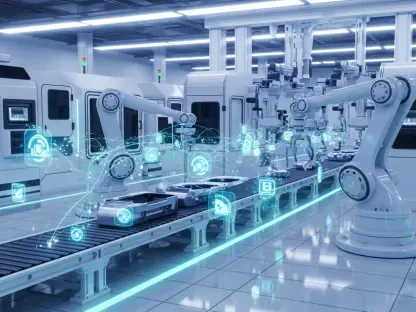In the fast-evolving landscape of modern industry, manufacturing stands at a critical juncture where technology is reshaping every facet of production, and automation, often viewed through the narrow lens of cost-cutting and efficiency, holds a treasure trove of underappreciated advantages that can redefine how manufacturers operate and compete. While the immediate benefits like reduced labor expenses and faster production cycles are well-documented, there’s a deeper, transformative potential that remains largely untapped. This exploration delves into the subtle yet powerful ways automation drives innovation, sustainability, and agility, offering manufacturers a competitive edge in a demanding market. Far beyond mere numbers on a balance sheet, the true value of automation lies in its ability to unlock human potential and foster long-term growth. By looking past traditional metrics, a fuller picture emerges, revealing why embracing these technologies is not just an option but a strategic imperative for forward-thinking companies.
Unlocking Innovation Through Automation
The integration of automation into manufacturing processes does more than streamline repetitive tasks; it serves as a catalyst for groundbreaking innovation. When mundane activities such as data entry or manual spreadsheet management are handled by sophisticated systems, skilled employees are liberated to focus on creative problem-solving and strategic initiatives. This shift in focus allows teams to dedicate time to exploring cutting-edge designs, conducting additional simulations, and experimenting with novel materials that could revolutionize product offerings. The ripple effect is significant—automation creates an environment where ideas flourish, pushing the boundaries of what’s possible in product development. Moreover, this newfound freedom often leads to unexpected collaborations across departments, fostering a culture of ingenuity that can set a company apart in a crowded marketplace. As a result, manufacturers who invest in automation find themselves not just keeping pace with competitors but often leading the charge in industry advancements.
Another dimension of innovation spurred by automation is the ability to iterate designs at an unprecedented pace. Automated tools enable rapid prototyping and testing, allowing engineers to refine concepts quickly based on real-time feedback and data analysis. This accelerated cycle reduces the time from ideation to market, giving manufacturers a crucial edge in meeting evolving consumer demands. Beyond speed, automation minimizes human error in design and modeling, ensuring that each iteration is more precise and reliable than the last. Such precision translates into fewer costly revisions and a higher quality of output, which can enhance brand reputation over time. Additionally, the integration of real-time data insights empowers decision-makers to identify trends and adapt strategies proactively, ensuring that innovation is not a one-time event but a continuous process. This dynamic approach to design and production underscores how automation acts as a foundation for sustained creativity and market relevance in manufacturing.
Driving Sustainability and Efficiency
Automation’s impact on sustainability represents one of its most compelling yet often overlooked advantages in the manufacturing sector. By optimizing processes such as resource allocation and energy consumption, automated systems significantly reduce waste and lower the environmental footprint of production activities. For instance, precision in design and manufacturing cuts down on material overuse, while smart scheduling ensures machinery operates only when necessary, conserving energy. These efficiencies contribute to broader goals like reducing embodied carbon in products, aligning with global priorities for greener practices. Manufacturers adopting automation can position themselves as leaders in environmental responsibility, appealing to eco-conscious consumers and stakeholders. This alignment with sustainability not only enhances corporate image but also ensures compliance with increasingly stringent regulations, avoiding potential fines and fostering long-term operational stability.
Beyond environmental benefits, automation enhances operational efficiency in ways that traditional metrics often fail to capture. Automated systems provide scalability, allowing production to ramp up or down without a proportional increase in staffing costs, which is vital for handling fluctuating market demands. Additionally, the reduction of human error through automation leads to fewer production defects, minimizing the need for rework and conserving both time and resources. This reliability extends to supply chain management, where automated tracking and forecasting improve inventory control, preventing overstocking or shortages. The cumulative effect is a leaner, more responsive operation that can adapt swiftly to external pressures. Furthermore, the data-driven insights offered by automation enable continuous process optimization, identifying bottlenecks before they escalate into costly disruptions. This holistic improvement in efficiency underscores how automation serves as a backbone for sustainable growth in manufacturing.
Enhancing Agility and Customer Satisfaction
In an era where market dynamics shift rapidly, automation equips manufacturers with the agility needed to stay ahead of the curve. The ability to respond to client needs in real time through faster design iterations and streamlined production schedules is a game-changer. Automated systems facilitate quick adjustments to project timelines and specifications, ensuring that manufacturers can meet tight deadlines without compromising quality. This responsiveness not only strengthens client relationships but also boosts competitiveness in an industry where speed often determines success. Moreover, automation’s role in providing accurate project updates and timelines enhances transparency, building trust with customers who value reliability. As a result, manufacturers leveraging these technologies often see improved retention rates and the potential for increased revenue through repeat business and referrals.
Another critical aspect of automation’s impact on agility lies in its capacity to integrate processes across departments for seamless collaboration. Platforms like Salesforce or Microsoft Dynamics 365 can connect engineering, sales, and production teams, breaking down silos and creating a unified data ecosystem. This integration ensures that everyone operates with the same real-time information, reducing miscommunication and accelerating decision-making. For example, linking CAD and PLM systems with customer relationship tools streamlines communication, allowing for immediate feedback loops that refine outputs to better match client expectations. The result is a more cohesive operation that can pivot swiftly in response to market shifts or customer demands. Additionally, this interconnected approach supports compliance by maintaining consistent records across functions, mitigating risks of oversight. By fostering such operational harmony, automation becomes a strategic enabler of both agility and enhanced customer satisfaction.
Reflecting on Strategic Transformation
Looking back, the journey of automation in manufacturing reveals a profound shift from merely a tool for efficiency to a cornerstone of strategic transformation. It has reshaped how industries approach innovation by freeing up talent for creative endeavors and accelerating design cycles with unmatched precision. Sustainability emerged as a defining achievement, with automated systems curbing waste and aligning operations with environmental imperatives. Agility, too, became a hallmark of automated processes, enabling manufacturers to adapt swiftly to market changes while deepening customer trust through transparency and reliability. As the past unfolded, it became evident that automation’s true power lay in its multifaceted impact, far beyond the scope of traditional financial metrics. Moving forward, manufacturers are encouraged to adopt a broader evaluation framework, prioritizing platforms that integrate seamlessly across functions to maximize these hidden benefits. Embracing this holistic perspective promises not just survival but a thriving presence in an ever-competitive landscape.









